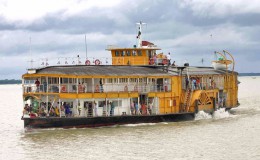ITINERARY
Day One: Drive to the Sadarghat River Terminal in the evening to get on board the Rocket Steamer. Overhingt on Board
Day Two: Relax the whole day on board. Enjoy the riverside beauty and activities of common people by the river. Disembark in the evening at Mongla. Check into the Hotel. Overnight at Mongla
Day Three: Morning drive to Bagerhat to visit the Sixty Domed Mosque, Nine Domed Mosque, and the Tomb of Hazrat Khan Jahan Ali (R:) among other ancient structures. Drive to Kuakat in the afternoon. Overnight at Kuakata
Day Four: Enjoy the day on the beach and visiting the tribal villages around the city. Overnight at Kuakata
Day Five: Drive in the morning to Dhaka. Arrive in Dhaka in the evening crossing the mighty River Padma on your way. Tour ends
HIGHLIGHTS
Sadarghat River Terminal
Sadarghat a large ghat or wharf at Dhaka city's approach to the River Buriganga. Originally, it was built as a place for landing of boats, launches and even ships coming to Dhaka from other places. Established in the 19th Century, this is said to be one of the largest river ports in the world. Every day about 30,000 people and about 200 large and small passenger launches depart and arrive at the terminal.
Rocket Steamer
Steam paddle boats, locally known as ‘Steamers’, ‘steamer rockets’ or simply ‘Rockets’, were introduced in Bangladesh in the second quarter of 19th Century. Originally these passenger vessels used to operate with steam engines produced in Denny yard on the Clyde. But in 1995 all of the steam engines have been replaced by diesel engines. The three rocket steamers that still operate between Dhaka and Khulna are Mahsud, Ostrich, and Lepcha. Having a trip on a steamer lets you relax for a while and gives you a very interesting introduction of the rural Bangladesh.
Sixty Domed Mosque
This is the largest of the Sultanate mosques in Bangladesh and one of the most impressive Muslim monuments in the whole of the Indian subcontinent. Built in the 16th Century, the mosque does not have sixty Domes as the name might mislead, rather sixty Pillars and 77 domes. Probably the name sixty Gumbad (Pillars) turned into Gambud (Dome) to raise such name in Bangla.
The mosque proper, built mainly of bricks, forms a vast rectangle and measures externally, inclusive of the massive two-storied towers on the angles, 48.77m from north to south and 32.92m from east to west. The huge of the building has been supported by Stone pillars. It is one of the three UNESCO heritage sites of Bangladesh and offers a tranquil neighbourhood for the visitors. There is a museum at the site to make a visit through the history for you too.
Nine Domed Mosques
Nine-Dome Mosque is located on the western bank of the Thakurdighi, less than half a km southwest to the tomb-complex of Khan Jahan. The mosque is now a protected monument of the Department of Archaeology, Bangladesh.
This 16th Century mosque is a brick-built square structure measuring about 16.76m externally and 12.19m internally. The 2.44m thick walls on the north, south and east sides are pierced with three arched-openings on each side; the central one, set within a rectangular frame, is larger than the flanking ones.
Tomb of Hazrat Khan Jahan Ali (R:)
Khan Jahan Ali is a local ruler and celebrated sufi saint, who seems to have come to Bengal just after the sack of Delhi (1398) by Timur. He acquired the forest area of the Sundarbans as jagir (fief) from the sultan of Delhi and subsequently from the sultan of Bengal. He was a great builder. He founded some townships, built mosques, madrasahs and sarais, roads, highways and bridges, dug a large number of dighis in the districts of greater Jessore and Khulna.
This Saint Ruler died in 1459 and was buried in the tomb built by himself. He is revered by people and numerous people visit his tomb. An annual fair is held on the tomb premises in the first half of April every year.
Kuakata Beach
Located in the central region of south of Bangladesh in the Barisal Division, this sea beach is interesting in the sense that you can see both the sun rise and the sun set from the same spot. The locality offers a very rich cultural diversity including tribal community and fishmongers. The beach offers a year round mild sun, which is ideal for sunbath.
Padma River
Padma River is the downstream of the Ganges, more precisely, the combined flow of the Ganges and the Jamuna after their confluence at Goalanda Ghat. The river is 120 km long and from 4 to 8 km wide. Average depth of the river is 295m. The Ganges-Padma is the major hydrodynamic system that formed one of the world's largest deltas covering a major portion of Bangladesh and also a greater part of West Bengal in India. The significance of the river does not lie only in helping irrigation, housing thousands of fishes, but also the alluvial soil it carries down from the Himalayans that fertile our farmland.




